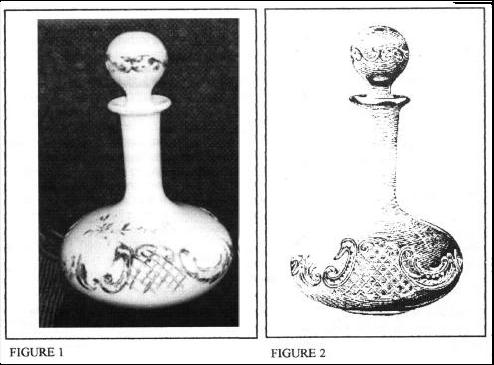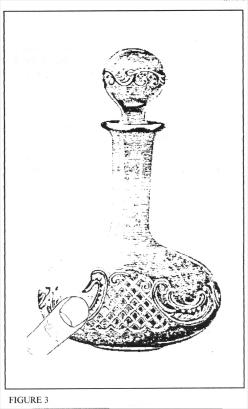The Opal Novelty Decanter No. 308
by Joseph A. A. Bourque Sr.
Issue 301 - May 1998
While attending a local country auction I spotted an old "milk glass" decanter with stopper inside a box lot. Upon examining it, my heart skipped a beat. I recognized a certain design I had been seeking for over 20 years. I immediately replaced it as gingerly as I had picked it up. I showed absolutely no interest in it by moving right along to the next box lot.
The local auction crowds are mostly antique and/or collectible dealers and get to know each other. Very few of them can identify Cambridge glass. Those that know me realize I'm a student of glass and know I collect Cambridge. The last thing I want my competitors to know is that I'm interested in a certain piece of Cambridge. This way it keeps the bidding down for me.
As casually as I could gather myself to do, I walked to the rear of the hall and sat down. I had a bad case of Triangle-C Jitters, and not only because I knew that beautitul old white glass decanter was Cambridge. What I also knew was that on the bottom of that box lot I had seen, there was another identical decanter! After searching 20 years and never seeing one, then suddenly seeing a pair within a few seconds was quite a surprise to me.
As I sat back In my chair thinking about the two white glass
decanters I wondered whether or not they were damaged; I wondered how
 much I was willing to pay for them; I wondered how long I would have to
wait for them before they were put up for sale. As I was having this
latter thought, let me tell you that all this anxiety ended about one
minute later.
much I was willing to pay for them; I wondered how long I would have to
wait for them before they were put up for sale. As I was having this
latter thought, let me tell you that all this anxiety ended about one
minute later.
Just about the moment I sat down, the auction started. The very first item to go up for sale was that box lot containing the two decanters. My Triangle-C Jitters doubled, but I came out a winner. I was able to purchase the box lot. I became the proud owner of those two No. 308 decanters depicted in Figure No. 1.
Both decanters are perfect, as is one stopper, the other having been damaged at the bottom, but was repaired. My joy does not stop here. I had purchased an exact stopper about ten years back, which is a perfect fit and match.
DESCRIPTION: Decanter and Stopper No. 308; vessel capacity, 30
ounces; vessel is three blown mold and the stopper is four blown mold;
type of decoration: embossed; design: vessel - crosshatcbed medallion
w/ "C" scroll designs on either side, one complete design in each of
three sections separated by the three equidistant mold marks; design:
stopper - single band of "C" scrolls;
 color white; type of bottle:
squat with long neck having inner grind for stopper; type of stopper:
ball type with cut-shut style bottom (usual small nub protruding). Most
of the embossing design was gilded, and they each have a painting in
oils of flowers and sprigs, probably forget-me-nots.
color white; type of bottle:
squat with long neck having inner grind for stopper; type of stopper:
ball type with cut-shut style bottom (usual small nub protruding). Most
of the embossing design was gilded, and they each have a painting in
oils of flowers and sprigs, probably forget-me-nots.
The Mysterious Mark To Look For:
Dear Readers, as a sequel to my article, I'm going to share the mysterious design to look for with you. Once you know it, you should never forget it. I remembered it for 21 years. (Bear in mind that there are plenty of these look-alike milk glass type of decanters around, at least in the different shops I go through, and unless they have the embossing from a Cambridge catalog, they may be difficult to identify.)
Look at Figure No, 2. and note the large cross-hatching (or trellis-type) design. Touching the left side of this trellis design is a rather large inverted "C" scroll design. Using the tip of your left index finger, cover the bottom curl of this "C" scroll design. Your left index finger is now pointing at the HEAD AND NECK OF A SWAN (a Cambridge Swan, that is). If you can't find it, look at the photo on the right, Figure No. 3 where it is pointed out.
I hope you each find a Triangle-C Swan Decanter in opal glass.
Until next time,
Joe
